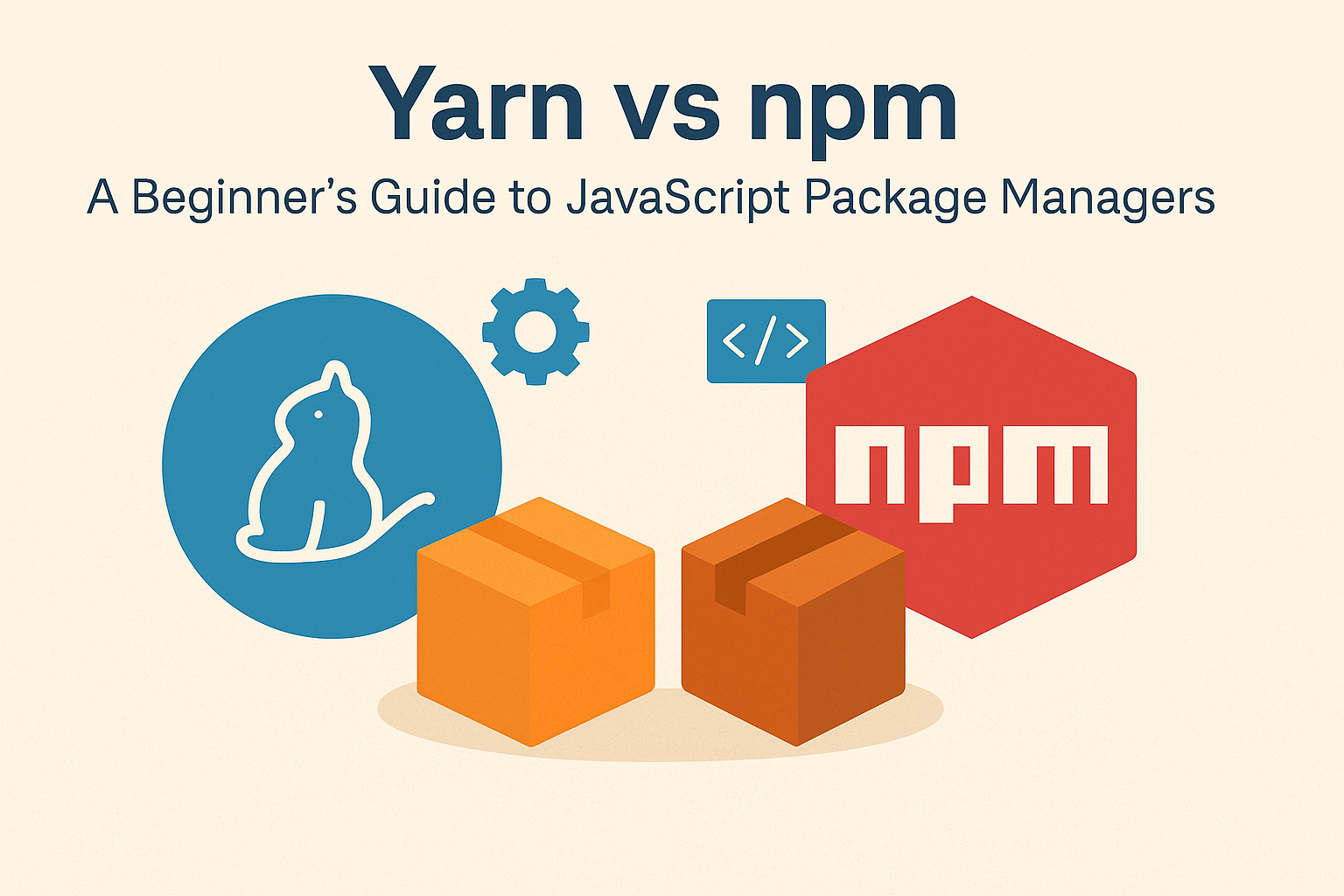📦 Yarn vs npm: A Beginner’s Guide to JavaScript Package Managers
🧠 What is a Package Manager?
A package manager automates the process of:
- Installing libraries (called packages or dependencies)
- Managing package versions
- Handling updates
- Publishing your code as reusable packages
You use them in JavaScript projects (React, Angular, Vue, Node.js, etc.) to bring in reusable code.
📌 Meet the Players: npm, Yarn & pnpm
| Tool | Full Form | Role |
|---|---|---|
| npm | Node Package Manager | Default package manager for Node.js |
| Yarn | Yet Another Resource Negotiator | Alternative to npm with speed & stability |
| pnpm | Performant npm | Fastest and disk-efficient manager |
📦 npm (Node Package Manager)
🔍 What is npm?
npm comes pre-installed with Node.js and is the world’s largest software registry.
✅ Key Features
- Versioning
package.jsontracking- Install, remove, update, and publish packages
🔧 Common npm Commands
npm init
npm install
npm install <pkg>
npm uninstall <pkg>
npm update
npm run <script>🧶 Yarn (by Meta/Facebook)
🔍 What is Yarn?
Yarn was created to solve npm’s earlier issues—focusing on speed, consistency, and offline caching.
✅ Key Features
- Faster installs
- Deterministic
yarn.lockfile - Parallel installs
🔧 Common Yarn Commands
yarn init
yarn add <pkg>
yarn remove <pkg>
yarn install
yarn upgrade
yarn run <script>✅ Yarn 2 (Berry)
- Plug’n’Play (no
node_modules) - Better monorepo and TypeScript support
⚡ pnpm (Performant npm)
🔍 What is pnpm?
pnpm is a modern alternative to npm and yarn. It uses hard links to avoid duplicating files across projects.
✅ Why Use pnpm?
- Disk-efficient
- Fast installs
- Strict dependency rules
🤝 npm vs Yarn vs pnpm – Comparison
| Feature | npm | Yarn | pnpm |
|---|---|---|---|
| Speed | Moderate | Fast | Fastest |
| Disk Space | High | Moderate | Low |
| Lockfile | package-lock.json |
yarn.lock |
pnpm-lock.yaml |
| Offline Install | Limited | Excellent | Excellent |
| Plug’n’Play | ❌ | ✅ | ✅ |
| Monorepo Support | ❌ | ✅ | ✅ |
| Strict Versioning | ❌ | ❌ | ✅ |
Beginner Tip: Start with npm, then explore Yarn or pnpm for advanced workflows.
🌐 Real-World Example
Building a React App:
npm install react-router-dom axios formikor using Yarn:
yarn add react-router-dom axios formikThese install and save dependencies in package.json and node_modules.
🔐 Why Are These Tools Important?
- Dependency Management
- Version Control with lock files
- Automation using npm/yarn scripts
- Security with audit features
- Scalability for large applications
💼 Interview Questions & Answers
1. What is npm and why do we use it?
Answer: npm is the default package manager for Node.js. It helps manage and install JavaScript packages efficiently.
2. How is Yarn different from npm?
Answer: Yarn was built for faster, more stable installs with better caching and deterministic builds.
3. What is a lock file?
Answer: It ensures the same dependency versions are installed across environments for consistency.
4. Why would you use pnpm?
Answer: For faster performance, disk savings, and strict dependency rules, especially in monorepos.
5. Can npm and Yarn be used together?
Answer: Not recommended. Choose one to avoid version conflicts.
🧩 Pro Tips for Beginners
- Always commit
package.jsonand lock files - Don’t touch
node_modulesdirectly - Use
npm auditoryarn auditto check for vulnerabilities - Keep your dependencies minimal and clean
🔚 Conclusion
Package managers like npm, Yarn, and pnpm are the backbone of modern web development. They help manage libraries, keep your code consistent, and automate builds and deployments.
Without them, every developer would need to manually download and configure code libraries — imagine the chaos!


